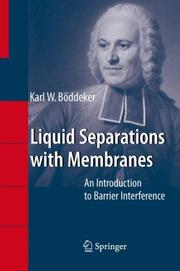| Listing 1 - 3 of 3 |
Sort by
|
Book

Year: 2018 Publisher: [Golden, Colo.] : U.S. Department of Energy, Office of Energy Efficiency & Renewable Energy,
Abstract | Keywords | Export | Availability | Bookmark
 Loading...
Loading...Choose an application
- Reference Manager
- EndNote
- RefWorks (Direct export to RefWorks)
Book
Year: 2004 Publisher: Washington, D.C. : U.S. Dept. of Energy, Office of Energy Efficiency and Renewable Energy,
Abstract | Keywords | Export | Availability | Bookmark
 Loading...
Loading...Choose an application
- Reference Manager
- EndNote
- RefWorks (Direct export to RefWorks)
Reverse Osmosis (RO) is a method of purifying water for industrial processes and human consumption; RO can remove mineral salts as well as contaminants such as bacteria and pesticides. Advances in water treatment technologies have enhanced and complemented the conventional RO process, reducing energy and water consumption, lowering capital and operating costs, and producing purer water. This publication of the Department of Energy's Federal Energy Management Program introduces RO, describes the benefits of high-efficiency reverse osmosis (HERO), and compares HERO with RO/electrodeionization (EDI) technology.
Water --- Reverse osmosis. --- Membrane separation. --- Purification.

ISBN: 1281139610 9786611139612 3540474536 354047451X 3642079970 Year: 2008 Publisher: Berlin ; New York : Springer,
Abstract | Keywords | Export | Availability | Bookmark
 Loading...
Loading...Choose an application
- Reference Manager
- EndNote
- RefWorks (Direct export to RefWorks)
On the level of a textbook a self-consistent approach to liquid separations with membranes is presented, contrasting equilibrium separations with the rate-controlling effects of barrier interference on mass transfer. As a corollary objective, an effort is made to observe context, factual and historical, when introducing concepts and applications of membrane separation science. Ordering principle is the formal structure of mass transfer across barriers, being construed of a driving force (allocated to the condition of the mixtures to be separated) and a barrier permeability (holding the keys to membrane selectivity). The membranes, by this approach, appear by way of the mass transport demands which they are to meet, or else by way of the separation effects which they inspire. Learning by principles and context – exploiting barrier interference is the challenge of membrane separation science and technology. This book is about the principles behind.
Membrane separation. --- Filtration, Membrane --- Membrane filtration --- Separation, Membrane --- Separation (Technology) --- Chemical engineering. --- Chemistry, Physical organic. --- Biotechnology. --- Biochemical engineering. --- Environmental pollution. --- Industrial Chemistry/Chemical Engineering. --- Physical Chemistry. --- Biochemical Engineering. --- Waste Water Technology / Water Pollution Control / Water Management / Aquatic Pollution. --- Chemical pollution --- Chemicals --- Contamination of environment --- Environmental pollution --- Pollution --- Contamination (Technology) --- Asbestos abatement --- Bioremediation --- Environmental engineering --- Environmental quality --- Factory and trade waste --- Hazardous waste site remediation --- Hazardous wastes --- In situ remediation --- Lead abatement --- Pollutants --- Refuse and refuse disposal --- Bio-process engineering --- Bioprocess engineering --- Biochemistry --- Biotechnology --- Chemical engineering --- Genetic engineering --- Chemistry, Physical organic --- Chemistry, Organic --- Chemistry, Physical and theoretical --- Chemistry, Industrial --- Engineering, Chemical --- Industrial chemistry --- Engineering --- Chemistry, Technical --- Metallurgy --- Environmental aspects --- Physical chemistry. --- Water pollution. --- Aquatic pollution --- Fresh water --- Fresh water pollution --- Freshwater pollution --- Inland water pollution --- Lake pollution --- Lakes --- Reservoirs --- River pollution --- Rivers --- Stream pollution --- Water contamination --- Water pollutants --- Water pollution --- Waste disposal in rivers, lakes, etc. --- Chemistry, Theoretical --- Physical chemistry --- Theoretical chemistry --- Chemistry
| Listing 1 - 3 of 3 |
Sort by
|

 Search
Search Feedback
Feedback About UniCat
About UniCat  Help
Help News
News